Start-up of North Korean Experimental Light Water Reactor Could Begin by Mid-2013 if Fuel is Available
Summary
According to new commercial satellite imagery, North Korea is nearing completion of an experimental light water reactor (ELWR) that is primarily intended to generate electricity for civilian purposes. The North now appears to be putting the finishing external touches on the reactor and may be completing work inside the building as well. The key factor determining whether Pyongyang can then move on to the start-up period within the next few months—which precedes regular operation of the reactor—is the availability of reactor fuel. Pyongyang unveiled a uranium enrichment plant nearby in 2010 and experts believe that, if the facility has been operating over the past few years, it may have produced sufficient low-enriched uranium that can be used to power the ELWR for several years. This would mean start up activities could begin in the coming weeks. However, it remains unclear to what capacity the facility has been operating. Also unclear is whether the North has mastered the technology for producing the fuel assemblies necessary to power the reactor.
If the North has fuel on hand it will then need to conduct a number of activities during the start-up period which normally takes 9-12 months for commercial power reactors before moving to a full power test and the facility becomes operational. Before loading the nuclear fuel, extensive verification and validation steps will need to be taken to assure the design, manufacture, assembly of nuclear components and construction meet whatever requirements the North Koreans have set for the safe and successful operation of the reactor. But it is worth noting that since Iran has suffered repeated setbacks in operating its own light water reactor, North Korea may have similar troubles. If the start-up period proceeds smoothly, the ELWR could become fully operational during the first half of 2014.
Because North Korea lacks experience in designing, engineering, manufacturing and operating light water reactors, it may also run into difficulties operating the ELWR, which raises serious safety concerns. For example, if defective fuel is inserted into the core, the cladding may fail to maintain physical integrity and release fission products possibly into the pressure vessel and containment building, forcing a shut down. Iran recently unloaded the fuel from its Bushehr reactor, implying a serious safety problem. Operating the reactor cooling system may also pose challenges as the Iranians discovered when a faulty pump led to lengthy delays in 2011. Moreover, North Korea has no experience in the specialized task of fabricating the large steel pressure vessels that contain the reactor core. Considerable care must be taken to ensure that the welds holding the vessels together can survive the highly radioactive environment of a nuclear core or risk a catastrophic loss of pressurized coolant that would result in a meltdown. Finally, as the Fukushima event in Japan demonstrated, even a well designed, constructed and tested plant must be capable of addressing unanticipated contingencies such as natural disasters. It is unclear whether the North can deal with such events.
Installation of Reactor Equipment
North Korea has made rapid progress over the past year in building its ELWR. An important milestone was reached last year when Pyongyang placed a dome over the reactor containment building. At the time, some observers wondered whether North Korea had sufficient time to install heavy equipment inside the building, such as the pressure vessel to hold the reactor core, before the dome was put in place. However, it may have been possible for the North to complete that task more rapidly than expected given the small size of the reactor.
Figure 1. Dome emplaced by November 2012.
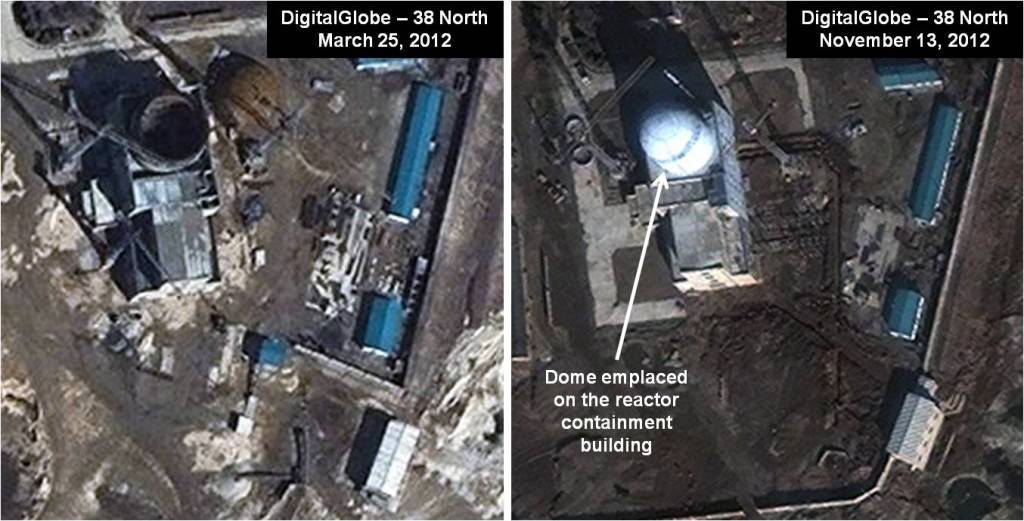
Satellite imagery suggests that North Korea may have begun to install additional equipment in the reactor hall beginning in September 2012. Several large containers and possible equipment covered by tarps visible that month (see figure 2) were no longer present by November. The contents may have been unloaded and placed inside the reactor building. Since nuclear reactors contain equipment of all sizes, it is not possible to positively identify the specific components but they were of sufficient size—generally about three meters by three meters and of varying heights with one rectangular eight meter by four meter object—to contain items such as smaller pumps, piping and electrical equipment.
Figure 2. Possible containers for reactor components.
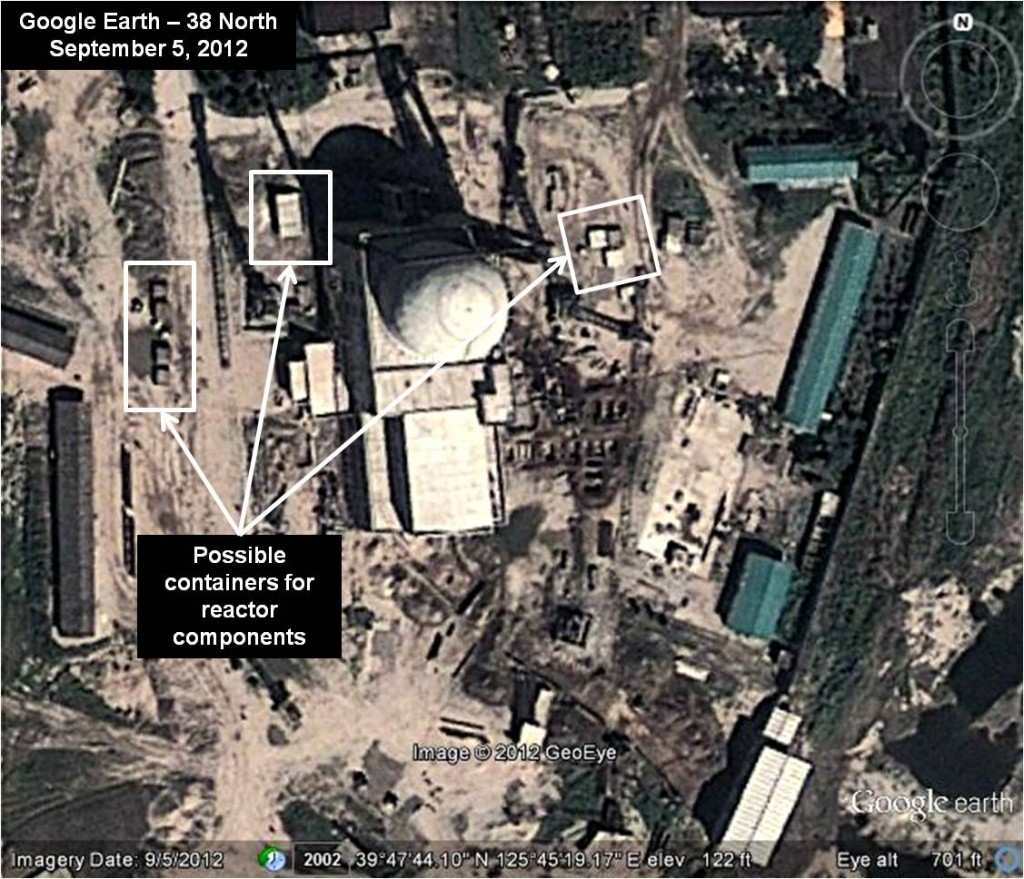
Finishing Touches on Water Cooling System
After working for two years on the water cooling system designed to draw water from and return it to the river, the North now appears nearing completion of this system.[1] Google Earth imagery from May 2011 shows a pair of deep trenches most likely intended to accommodate piping that will bring and return water held in several man made ponds to the west of the pump house. (The trenches terminate at circular structures sitting in man made ponds for holding water.)
Figure 3. Piping trenches for water cooling system.
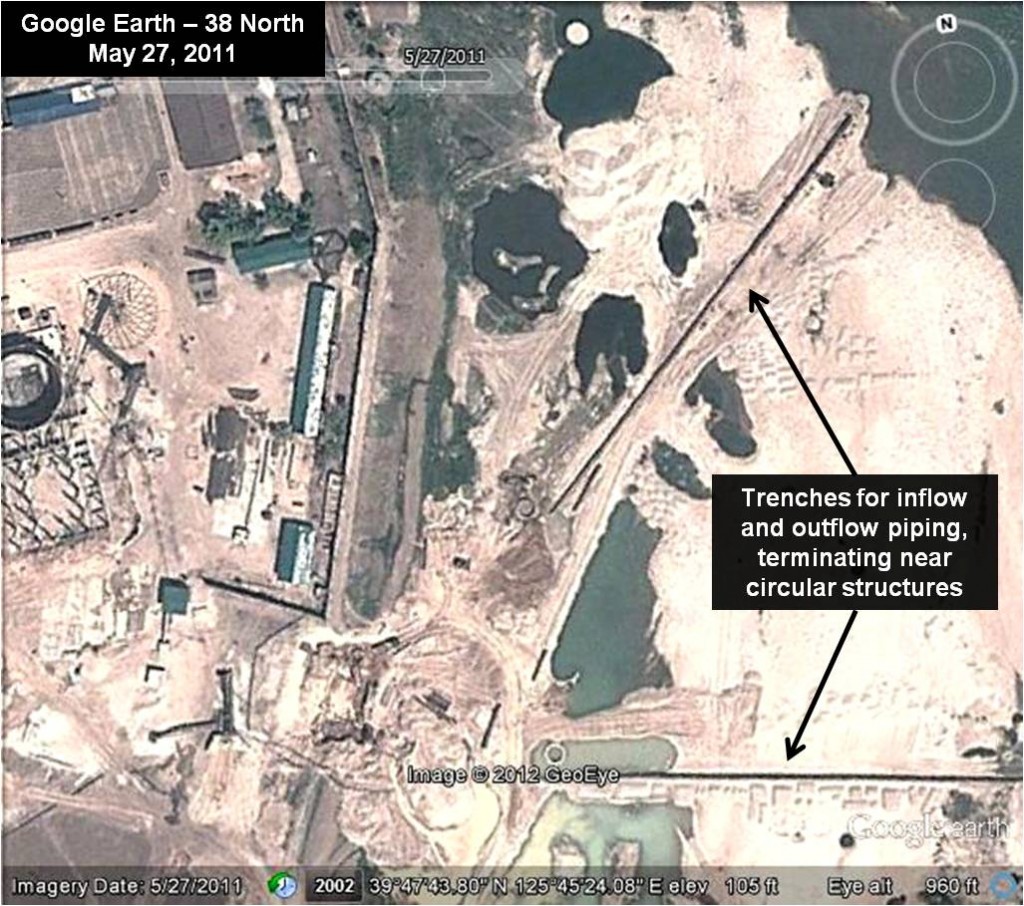
By September 2012, the pipes were submerged, but the two circular structures are clearly visible, sitting in ponds holding the water that will be used to cool the reactor and then returned to the river.
Figure 4. Pipes submerged; only circular structures visible.
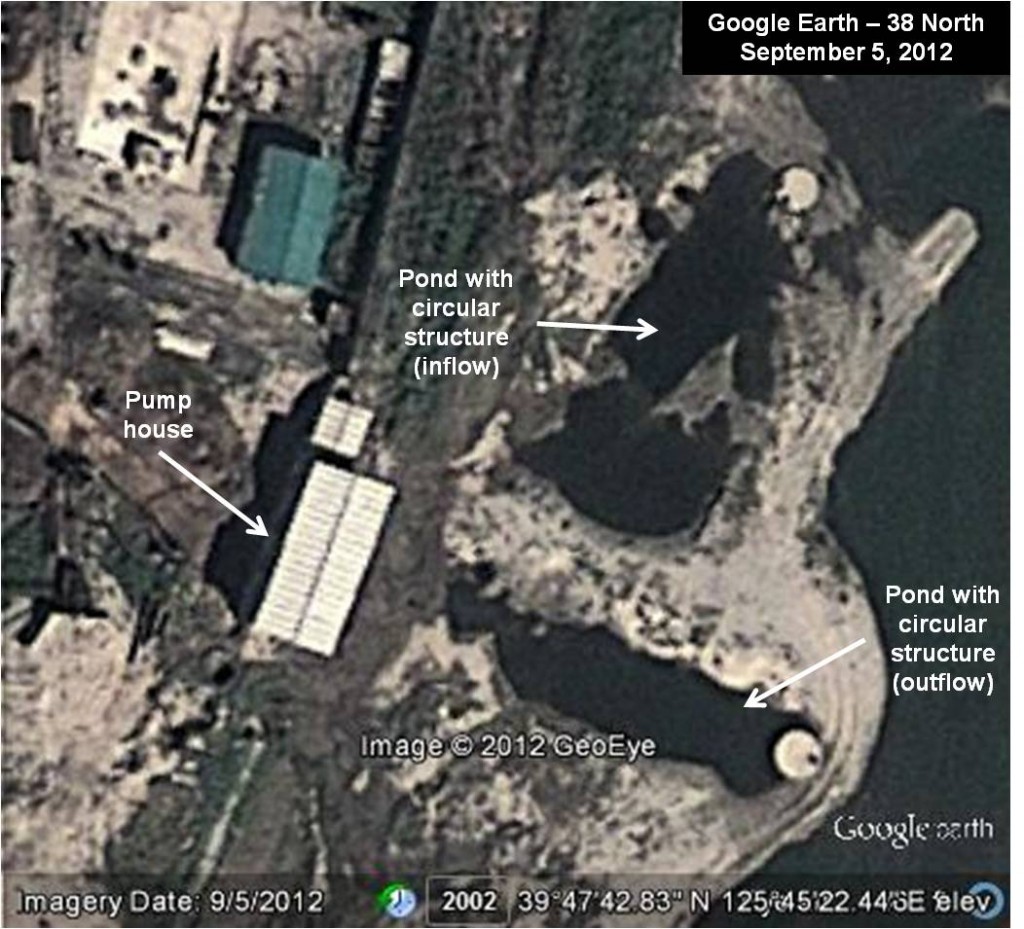
In November 2012, a trench for piping appears to be visible connecting the pump house to the reactor (see figure 5). (One would expect, as we see here, that the feed and return systems will flow through the turbine hall.) In the snow-covered January image, the trench is covered, suggesting that the piping is in place (see figure 6).
Figure 5. New trench for piping visible.

To the west of the reactor containment building, there are two large circular rings that appear to be for condensate or make-up water storage tanks—another important element of the cooling system. (Make-up water is recycled into the cooling system to compensate for evaporation losses.) In the January 2013 image, similar rings have been installed next to the spent fuel storage building.
Figure 6. Possible water storage tanks installed.

Construction of Electrical Substation
To the east of the turbine building,North Korea appears to be nearing completion of an electrical substation, sometimes called a “switchyard,” where all electric transfers are done. (Reactors not only generate electricity for the power grid, but also need offsite power to operate and a backup system of diesel generators in case power is lost.) Construction started around fall of last year.
Figure 7. Electrical substation components.

In addition to the possible switchyard, there are several tall structures on what remains of the sandbar in the river that are connected by dirt road to the main complex. One of these appears to be tower for large power lines leading out of the reactor complex to connect it to the power grid.
Figure 8. Possible tower for large power lines.
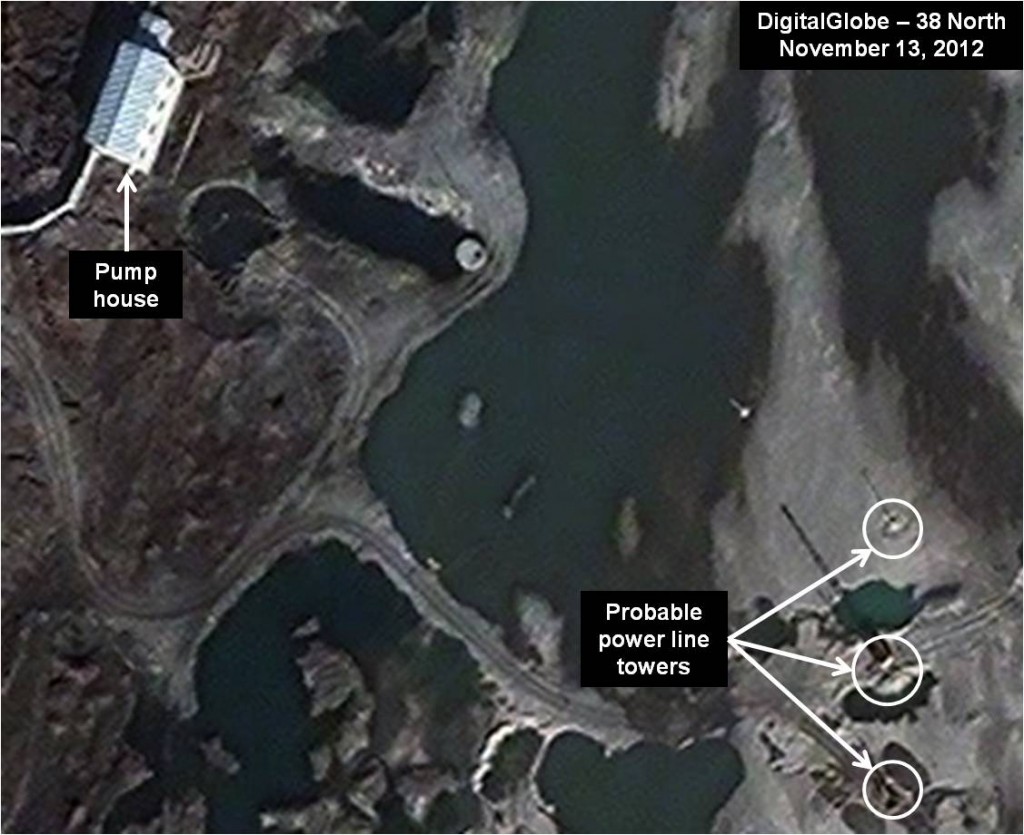
Satellite imagery from February 7, 2013, shows the external construction of the building is complete. The large crane on the east side of the building is being disassembled on the ground by a crane and was removed by late March. The cooling pipes from the pump house near the river to the reactor have been buried. The electrical substation on the east side of the building is not yet finished and has not yet been connected to the power line a little further to the east. The driveways leading into the entrances to the reactor have nearly been paved with some more work to be done on the east side. The majority of work is now being done inside the building precluding any insight from commercial imagery.
Figure 9. Completed reactor building.

By March, the North Koreans seem to be in the clean up phase of finishing the ELWR. The electrical substation on the east side of the building is nearing completion, while work seems to be continuing on the bare ground where the cooling pipes make the right angle turn and go into the reactor building. The large crane that had been taken down in February but not removed is now gone, and at the south end of the reactor building a trench for a pipe to return water to the river is now seen. On an April 4 image (not shown), another trench was seen leaving the reactor on its east side and running to the north. Most of the current work is probably being done inside, but they are not yet finished installing the reactor’s water and electrical connections.
Figure 10. New trench visible.

Conclusion
Pyongyang appears to be in the final “clean up” stage of completing the ELWR. However, producing fuel for the reactor remains an important and difficult hurdle. North Korea publicly disclosed an enrichment facility at Yongbyon in late 2010 and has claimed that it has begun enriching uranium at very low levels that could be used for manufacturing fuel rods, though these claims have not been confirmed. Moreover, developing technology for manufacturing fuel assemblies is a demanding task requiring in situ tests to validate safety performance before producing credible assemblies for the reactor. If the North has solved these problems and fuel is indeed available, the facility could begin a start-up period by mid-2013 that precedes the facility becoming fully operational.
If the North is ready to move forward, the start-up period, which typically lasts 9-12 months, will be used to conduct activities including fuel loading and physics tests before moving to a full power test. Prior to the nuclear fuel loading, extensive verification and validation steps will need to be taken to assure the design, manufacture, assembly of nuclear components and construction of major structures meet operational requirements. Given Pyongyang’s lack of experience in building this type of reactor, delays are quite possible during this phase. However, under a best-case scenario, the ELWR could become fully operational by the first half of 2014.
When the reactor starts operating, there is a danger that North Korea may experience difficulty in operating it safely. For example, if defective fuel is inserted into the core, the cladding may fail to maintain physical integrity and release fission products possibly into the pressure vessel and containment building, forcing a shut down. Iran recently unloaded the fuel from its Bushehr reactor, implying a serious safety problem—one of a series of delays that have afflicted its first light water reactor. Operating the reactor cooling system may also pose challenges as the Iranians discovered when a faulty pump led to lengthy delays in 2011. Moreover, North Korea does not have experience in the highly specialized task of fabricating the large steel pressure vessels that contain the reactor core. Considerable care must be taken to ensure that the welds holding the vessels together can survive the highly radioactive environment of a nuclear core or risk a catastrophic loss of pressurized coolant that would result in a meltdown. Finally, as the Fukushima event in Japan demonstrated, even a well designed, constructed and tested plant must be capable of addressing unanticipated contingencies such as natural disasters. It is unclear whether the North can deal with such events.
While the reactor seems designed to produce electricity for the civilian economy, it will have a residual capability to produce plutonium that can be used for nuclear weapons.[2]
[1] The steam created by cooling the reactor water is used to turn one or more turbines, generating electricity, and then condensed for recirculation via a water cooling system usually connected to large water sources such as a pond, river, sea or cooling tower(s) in case of inland construction.
[2] In a recent article published by 38 North, David Albright noted that North Korea could optimize the light water reactor to produce weapons grade plutonium if they decided to do so. According to his projection, under that scenario, the combined production of plutonium at the ELWR and highly enriched uranium elsewhere might enable the North to reach a stockpile of 28-48 nuclear weapons by 2016, depending on whether Pyongyang has one or two uranium facilities. See David Albright, “Challenges Posed by North Korea’s Weapon-Grade Uranium and Weapon-Grade Plutonium: Current and Projected Stocks,” 38 North, October 24, 2012, https://www.38north.org/2012/10/dalbright102312/.
